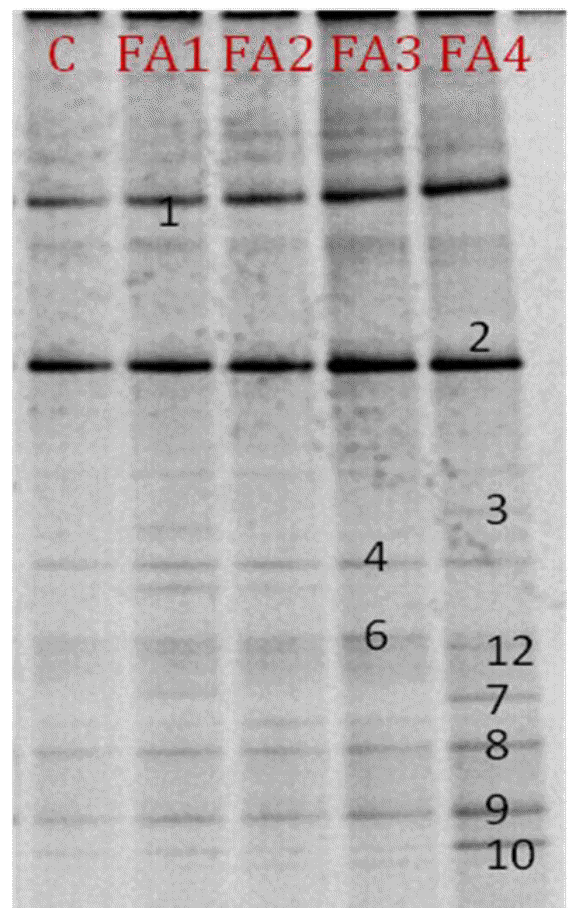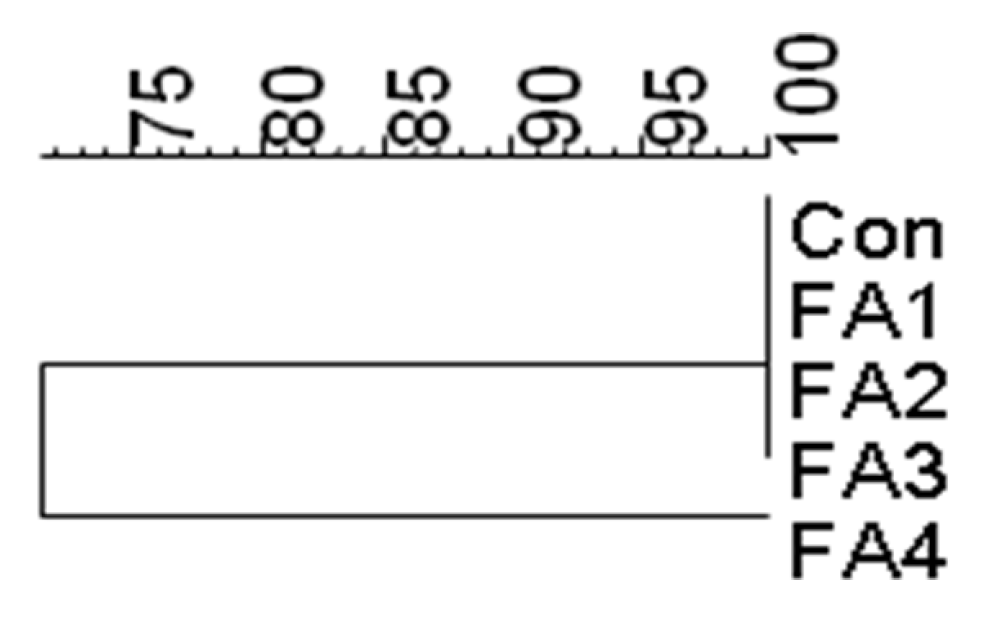Aarnink AJA, Le Dinh P, Ogink NWM, Becker PM, Verstegen MWA. 2005. Odour from animal production facilities: its relationship to diet. Nutr Res Rev 18:3–30.


Amon M, Misselbrook TH, Pain BF, Phillips VR, Sneath RW. 1995. A farm scale study on the use of de-odorase for reducing odour and ammonia emissions from intensive fattening piggeries. Bioresour Technol 51:163–169.

Bailey SR, Rycroft A, Elliott J. 2002. Production of amines in equine cecal contents in an
in vitro model of carbohydrate overload. J Anim Sci 80:2656–2662.


Bengtson H. 2010. Easy to understand diagram of nutrient cycle.
Chaney AL, Marbach EP. 1962. Modified reagents for determination of urea and ammonia. Clin Chem 8:130–132.


Colina JJ, Lewis AJ, Miller PS, Fischer RL. 2001. Dietary manipulation to reduce aerial ammonia concentrations in nursery pig facilities. J Anim Sci 79:3096–3103.


Cromwell GL. 1998. Manipulation of swine diets to reduce odors and harmful gaseous emissions from manure. University of Kentucky.
Cummings JH, Macfarlane GT. 1991. The control and consequences of bacterial fermentation in the human colon. J Appl Microbiol 70:443–459.

Fakhoury KJ, Heber AJ, Shao P, Ni JQ. 2000. Correlation of odor detection thresholds with concentrations of hydrogen sulfide, ammonia and trace gases emitted from swine manure. p. 1–13. American Society of Agricultural Engineers; St Joseph:
Gibson GR, Cummings JH, Macfarlane GT. 1988. Competition for hydrogen between sulphate-reducing bacteria and methanogenic bacteria from the human large intestine. J Appl Microbiol 65:241–247.

Han S-K, Kim S-H, Shin H-S. 2005. UASB treatment of wastewater with VFA and alcohol generated during hydrogen fermentation of food waste. Process Biochem 40:2897–2905.

Häne BG, Jäger K, Drexler HG. 1993. The pearson product-moment correlation coefficient is better suited for identification of DNA fingerprint profiles than band matching algorithms. Electrophoresis 14:967–972.


Hao OJ, Chen JM, Huang L, Buglass RL. 1996. Sulfate-reducing bacteria. Crit Rev Environ Sci Technol 26:155–187.

Hayes ET, Leek ABG, Curran TP, Dodd VA, Carton OT, Beattie VE, O’Doherty JV. 2004. The influence of diet crude protein level on odour and ammonia emissions from finishing pig houses. Bioresour Technol 91:309–315.


Hume ME, Clemente-Hernández S, Oviedo-Rondó EO. 2006Effects of feed additives and mixed eimeria species infection on intestinal microbial ecology of broilers. Poult Sci 85:2106–2111.


Jenkins D, Medsker LL. 1964. Brucine method for the determination of nitrate in ocean, estuarine, and fresh waters. Anal Chem 36:610–612.

Jensen MT, Cox RP, Jensen BB. 1995. Microbial production of skatole in the hind gut of pigs given different diets and its relation to skatole deposition in backfat. Anim Sci 61:293–304.

Jensen MT, Hansen LL. 2006. Feeding with chicory roots reduces the amount of odorous compounds in colon and rectal contents of pigs. Anim Sci 82:369–376.

Killeen GF, Connolly CR, Walsh GA, Duffy CF, Headon DR, Power RF. 1998. The effects of dietary supplementation with
Yucca schidigera extract or fractions thereof on nitrogen metabolism and gastrointestinal fermentation processes in the rat. J Sci Food Agric 76:91–99.

Kim K-Y, Ko H-J, Kim H-T, Kim Y-S, Roh Y-M, Lee C-M, Kim C-N. 2008. Odor reduction rate in the confinement pig building by spraying various additives. Bioresour Technol 99:8464–8469.


Kolmert Å, Wikström P, Hallberg KB. 2000. A fast and simple turbidimetric method for the determination of sulfate in sulfate-reducing bacterial cultures. J. Microbiol Methods 41:179–184.


Konstantinov SR, Christine FF, Wei Yun Z, Barbara AW, Jeannette K, Wolfgang-Bernhard S, Willem MDV, Antoon DLA, Hauke S. 2004. Microbial diversity studies of the porcine gastrointestinal ecosystem during weaning transition. Anim Res 53:317–324.

Konstantinov SR, Zhu W-Y, Williams BA, Tamminga S, de Vos WM, Akkermans ADL. 2003. Effect of fermentable carbohydrates on piglet faecal bacterial communities as revealed by denaturing gradient gel electrophoresis analysis of 16S ribosomal DNA. FEMS Microbiol Ecol 43:225–235.


Le PD, Aarnink AJA, Jongbloed AW. 2009. Odour and ammonia emission from pig manure as affected by dietary crude protein level. Livest Sci 121:267–274.

Le PD, Aarnink AJA, Jongbloed AW, Peet-Schwering CMCVd, Ogink NWM, Verstegen MWA. 2007. Effects of dietary crude protein level on odour from pig manure. Animal 1:734–744.


Mackie RI, Stroot PG, Varel VH. 1998. Biochemical identification and biological origin of key odor components in livestock waste. J Anim Sci 76:1331–1342.


Mao SY, Zhang G, Zhu WY. 2008. Effect of disodium fumarate on ruminal metabolism and rumen bacterial communities as revealed by denaturing gradient gel electrophoresis analysis of 16S ribosomal DNA. Anim Feed Sci Technol 140:293–306.

Miner JR. 1977. Characterization of odors and other volatile emissions. Agric Environ 3:129–137.

Morrison TB, Weis JJ, Wittwer CT. 1998. Quantification of low-copy transcripts by continuous SYBR Green I monitoring during amplification. Biotechniques 24:954–958. 960962

Muyzer G, Smalla K. 1998. Application of denaturing gradient gel electrophoresis (DGGE) and temperature gradient gel electrophoresis (TGGE) in microbial ecology. Antonie van Leeuwenhoek 73:127–141.


Naidu AS, Xie X, Leumer DA, Harrison S, Burrill MJ, Fonda EA. 2002. Reduction of sulfide, ammonia compound, and adhesion properties of
Lactobacillus casei strain KE99
in vitro. Curr Microbiol 44:196–205.


Nübel U, Engelen B, Felske A, Snaidr J, Wieshuber A, Amann RI, Ludwig W, Backhaus H. 1996. Sequence heterogeneities of genes encoding 16S rRNAs in
Paenibacillus polymyxa detected by temperature gradient gel electrophoresis. J Bacteriol 178:5636–5643.



Nyachoti CM, Omogbenigun FO, Rademacher M, Blank G. 2006. Performance responses and indicators of gastrointestinal health in early-weaned pigs fed low-protein amino acid-supplemented diets. J Anim Sci 84:125–134.


O’Connell JM, Sweeney T, Callan JJ, O’Doherty JV. 2005. The effect of cereal type and exogenous enzyme supplementation in pig diets on nutrient digestibility, intestinal microflora, volatile fatty acid concentration and manure ammonia emissions from finisher pigs. Anim Sci 81:357–364.

Oviedo-Rondón EO. 2009. Molecular methods to evaluate effects of feed additives and nutrients in poultry gut microflora. Revista Brasileira de Zootecnia 38:209–225.

Parker J, Oviedo-Rondón EO, Clack BA, Clemente-Hernández S, Osborne J, Remus JC, Kettunen H, Mäkivuokko H, Pierson EM. 2007. Enzymes as feed additive to aid in responses against eimeria species in coccidia-vaccinated broilers fed corn-soybean meal diets with different protein levels. Poult Sci 86:643–653.


Patra AK, Kamra DN, Agarwal N. 2006. Effect of spices on rumen fermentation, methanogenesis and protozoa counts in
in vitro gas production test. Int Congr Ser 1293:176–179.

Rainville N, Morin A. 1985. Change in the volatile fatty acids content of laboratory stored sterilized and non-sterilized swine wastes. Microbios 42:175–182.

Ritter WF. 1989. Odour control of livestock wastes: State-of-the-art in North America. J Agric Eng Res 42:51–62.

Robinson JA, Smolenski WJ, Ogilvie ML, Peters JP. 1989.
In vitro total-gas, CH
4, H
2, volatile fatty acid, and lactate kinetics studies on luminal contents from the small intestine, cecum, and colon of the pig. Appl Environ Microbiol 55:2460–2467.



SAS. 2002. SAS/STAT. Statistical Analysis Systems for Windows release 9.1. SAS Institute Inc; Cary, NC, USA:
Tabaru H, Kadota E, Yamada H, Sasaki N, Takeuchi A. 1988. Determination of volatile fatty acids and lactic acid in bovine plasma and ruminal fluid by high performance liquid chromatography. Japanese J Vet Sci 50:1124–1126.

Tannock GW. 1999. Probiotics: a critical review. Prebiotics Horizon Scientific Press
van Beers-Schreurs HMG, Nabuurs MJA, Vellenga L, Valk HJK-vd, Wensing T, Breukink HJ. 1998. Weaning and the weanling diet influence the villous height and crypt depth in the small intestine of pigs and alter the concentrations of short-chain fatty acids in the large intestine and bood. J Nutr 128:947–953.


Wang JF, Zhu YH, Li DF, Wang Z, Jensen BB. 2004.
In vitro fermentation of various fiber and starch sources by pig fecal inocula. J Anim Sci 82:2615–2622.


Windisch W, Schedle K, Plitzner C, Kroismayr A. 2008. Use of phytogenic products as feed additives for swine and poultry. J. Anim. Sci. 86:14 SupplE140–E148.


Zhu J. 2000. A review of microbiology in swine manure odor control. Agric Ecosyst Environ 78:93–106.

Zhu W-Y, Williams BA, Konstantinov SR, Tamminga S, De Vos WM, Akkermans ADL. 2003. Analysis of 16S rDNA reveals bacterial shift during
in vitro fermentation of fermentable carbohydrate using piglet faeces as inoculum. Anaerobe 9:175–180.











 PDF Links
PDF Links PubReader
PubReader ePub Link
ePub Link Full text via DOI
Full text via DOI Full text via PMC
Full text via PMC Download Citation
Download Citation Print
Print





